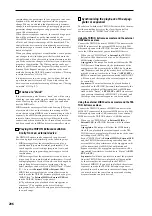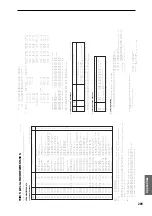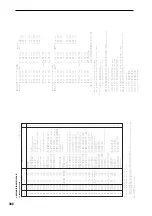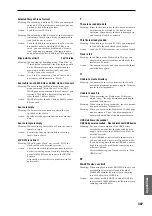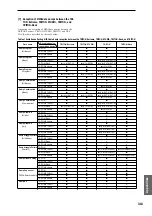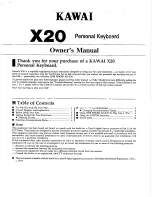
298
The TRITON Extreme automatically converts the GS/XG
sound maps into the GM2 sound map, and also supports
some of the GS/XG messages. This allows GS/XG music
data to be played back in Song Play mode.
Since the TRITON Extreme does not support all of the
GS/XG sound maps or messages, some data may not
be played back correctly.
When you wish to playback a music data conform to GM/
GS/XG format or load it into a song, set “Bank Map” (Glo-
bal P0: 0–2a) to GM(2).
In Sequencer mode, exclusive messages for XG/GS
data can be realtime-recorded on any track, but the
recorded XG/GS (GM) exclusive messages will not be
interpreted correctly by the TRITON Extreme during
playback.
Converting the GS/XG bank/program maps to the
GM2 bank/program map
• When bank select/program change messages used by
GS/XG are received, they will automatically be
converted to the G, g(1)–g(9), g(d) bank/program map
of the TRITON Extreme.
• The same conversion is performed when a SMF is
loaded into a song in Media mode.
For banks that are used in common by GS/XG, GS
Reset/XG System ON will be received to automatically
convert to the optimal bank/program map for each.
Support for GS/XG part mode exclusive messages
• In Song Play mode when GS/XG part mode exclusive
messages Drum or MDrm 1–4 are received, bank g(d)
(GM2 drum bank) will be selected for the specified track.
Until this part mode state is defeated, bank select mes-
sages will no longer be received for the specified track.
• When an SMF is loaded into a song in Media mode, any
bank select messages in a track that is set to a part mode
of Drum or MDrm 1–4 will be ignored, and will not be
loaded.
Support for NRPN messages used in GS/XG music
data
The following NRPN messages can be received to modify
the sound.
kk: Drum Inst No. ([0C...6C] corresponds to C0...C8)
*
[00, 01...7f] corresponds to Random, L000...R127)
About standard MIDI files
Standard MIDI files (SMF) make it possible for different
computer programs or musical instruments made by differ-
ent manufacturers to exchange time-based MIDI data. Each
standard MIDI file contains one song. The TRITON Extreme
supports format 0 (type 0) in which all of the MIDI data is
combined into one track, and format 1 (type 1) in which the
data is separated by track.
When a SMF is played back in Song Play mode or loaded
into a song in Media mode, the program bank that is
selected will differ depending on the “Bank Map” (Global
P0: 0–2a) setting. When playing/loading SMF data that con-
forms to the GM/GS/XG specifications, set “Bank Map” to
GM(2)
.
Song Play mode
• In Song Play mode, the TRITON Extreme can playback
SMF data directly from a disk or external SCSI device;
i.e., the data will be played back as it is being read, and
does not need to be loaded into memory.
• If the SMF data contains a GM System On message, the
TRITON Extreme will be initialized for GM playback
(
☞
“GM Initialize” Song Play P0: 0–1A).
Sequencer mode
In Media mode when you convert a song into a Standard
MIDI File and save it, you can choose either format 0 or for-
mat 1.
• If TRITON Extreme song data that was saved as a format
1 SMF file is loaded into another device, the track
configuration may be different than it was before being
saved. This is because tracks that contain no musical
data are omitted, and the remaining tracks are moved
into the unused tracks. This will not affect the playback
itself.
• If song data that was saved by another device as a
format 1 SMF file is loaded into the TRITON Extreme,
the track configuration may be different than it was
before being saved. This is because tracks that contain no
musical data are omitted, and the remaining tracks are
moved into the unused tracks. This will not affect the
playback itself.
When exchanging sequence data between two TRITON
Extreme, we recommend that you save the sequence data in
the TRITON Extreme’s native format (“Save SEQ”).
When sequence data is saved in the TRITON Extreme’s
native format, all of the settings and patterns unique to the
TRITON Extreme will be saved, which will ensure a higher
level of reproducibility than when the data is saved as a
Standard MIDI File (“Save to Std MIDI File”).
Since the recorded data is included in the song data as exclu-
sive events, it can be saved to disk or loaded from disk in the
usual way. Exclusive messages are also supported when
loading or saving SMF (Standard MIDI File) data (“Load
Standard MIDI File,” Save Song as Standard MIDI File”).
This means that exclusive events you record can be saved as
SMF data, and that exclusive messages included in SMF
data can be converted into song data.
During playback, this data will be transmitted to an external
MIDI device, or can be used to control track parameters or
effect parameters of the song.
Vibrato Rate
[Bn, 63, 01, Bn, 62, 08, Bn, 06, mm]
Vibrato Depth
[Bn, 63, 01, Bn, 62, 09, Bn, 06, mm]
Vibrato Delay
[Bn, 63, 01, Bn, 62, 0A, Bn, 06, mm]
Filter Cutoff
[Bn, 63, 01, Bn, 62, 20, Bn, 06, mm]
Resonance
[Bn, 63, 01, Bn, 62, 21, Bn, 06, mm]
EG Attack Time
[Bn, 63, 01, Bn, 62, 63, Bn, 06, mm]
EG Decay Time
[Bn, 63, 01, Bn, 62, 64, Bn, 06, mm]
EG Release Time
[Bn, 63, 01, Bn, 62, 66, Bn, 06, mm]
Drum Filter Cutoff
[Bn, 63, 14, Bn, 62, kk, Bn, 06, mm]
Drum Filter Resonance
[Bn, 63, 15, Bn, 62, kk, Bn, 06, mm]
Drum EG Attack Time
[Bn, 63, 16, Bn, 62, kk, Bn, 06, mm]
Drum EG Decay Time
[Bn, 63, 17, Bn, 62, kk, Bn, 06, mm]
Drum Coarse Tune
[Bn, 63, 18, Bn, 62, kk, Bn, 06, mm]
Drum Fine Tune
[Bn, 63, 19, Bn, 62, kk, Bn, 06, mm]
Drum Volume
[Bn, 63, 1A, Bn, 62, kk, Bn, 06, mm]
Drum Panpot
[Bn, 63, 1C, Bn, 62, kk, Bn, 06, mm]*
Drum Rev Send(Send2)
[Bn, 63, 1D, Bn, 62, kk, Bn, 06, mm]
Drum Cho Send(Send1)
[Bn, 63, 1E, Bn, 62, kk, Bn, 06, mm]
Summary of Contents for TRITON Extreme
Page 1: ...2 E ...
Page 11: ...xii ...
Page 111: ...100 9 5 Page Menu Command 0 1A 0 1I 0 1J Program 9 5A ...
Page 185: ...174 ...
Page 215: ...204 ...
Page 281: ...270 ...
Page 349: ...338 ...
Page 350: ...339 ...
Page 351: ...340 ...
Page 352: ...341 ...
Page 353: ...342 ...













